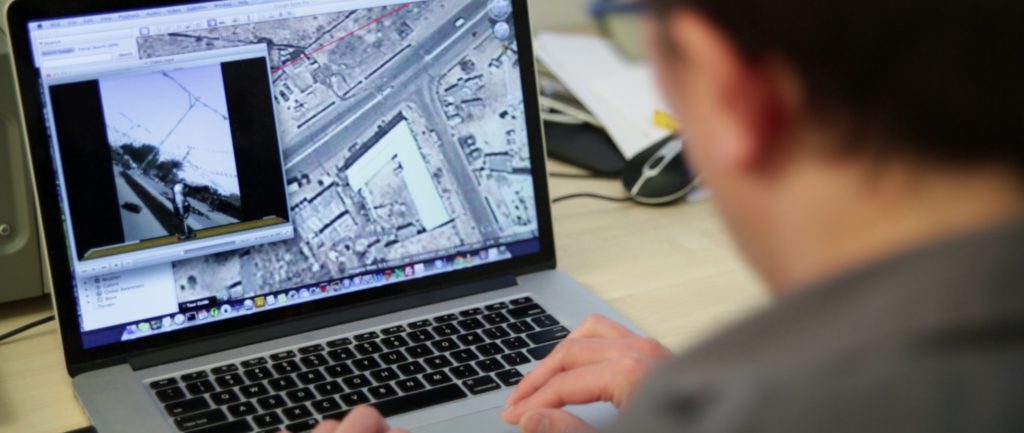The Evidence Lab receives information from a variety of sources, including what is known as “citizen evidence” - material that has been collected by someone other than an established human rights investigator
Amnesty International’s Crisis Evidence Lab is a multidisciplinary team that uses cutting-edge digital investigation tools to document human rights violations remotely. It helps to ensure that information emerging from conflict areas is timely, accurate and meets the needs of human rights work in crises situations.
This is particularly important in situations where it is dangerous for researchers to be on the ground, and in an era when disinformation and misinformation can spread rapidly.
The Evidence Lab has been working hard to identify and verify the details of possible unlawful attacks which have killed or injured civilians, and destroyed or damaged civilian infrastructure in Ukraine. This documentation provides essential evidence which can later be used to hold perpetrators of violations accountable.
The Evidence Lab collects audio-visual material and analyzes it for evidence of violations of international law. This material includes satellite imagery, video footage and photos of air strikes and other attacks, and of the aftermath of these attacks, as well as images of weapons remnants. Where possible, evidence is corroborated by interviewing witnesses to the attacks.
Below is a list of attacks by Russian forces in Ukraine which the Evidence Lab has verified to date. Some of these – including strikes on hospitals and schools, indiscriminate attacks which killed or injured civilians, and the use of banned cluster munitions – may constitute war crimes under international law.
*This list is regularly updated

Part of Amnesty’s Crisis Response Programme, the Evidence Lab brings together open source and visual investigators, remote sensing experts, weapons analysts, data scientists, developers and other experts to conduct digital investigations and tell the stories of people most affected by conflict.
The Evidence Lab website provides an online space to share best practices, new techniques, resources and guides, helping human rights investigators to take advantage of the vast amount of information which is shared online every day.
Find out more about their work here.
The Evidence Lab receives information from a variety of sources, including what is known as “citizen evidence” - material that has been collected by someone other than an established human rights investigator.
This sort of documentation is frequently shared publicly through social media networks such as Twitter, Facebook and YouTube, and often exposes in great detail abuses which might have otherwise gone unnoticed. The Lab also receives evidence directly from witnesses on the ground.
Depending on what they are looking for, Evidence Lab researchers use a range of verification methods. These include:
Geo and chrono-location
Confirming where and when a video or photo was taken. This can be done by cross-checking the material with satellite imagery, ground level photography and other publicly available information. A researcher can look at the landscape, trees, buildings, and streets in the images, and check if they match with street views or other photos from a known location.
The researchers can also analyze weather patterns and shadows to see if they match the conditions that prevailed when the photo or video was claimed to have been taken.
Remote sensing
The researchers use satellite imagery and other sensors such as Radar and LiDAR to look for tell-tale signs of attacks like destroyed buildings, craters, debris, troop or weapon movements. A bird’s eye view is also important to cross-check and verify potential targets and understand the dynamics of these attacks.
Weapons identification
Amnesty International’s arms experts analyze photos, videos and other data to verify which weapons are being used and if they lead to human rights violations. This could include studying the shape of a crater left by a missile, watching footage of air strikes, or examining photos of weapons remnants. The researchers also analyze weapons trade data to understand ownerships of these weapons
Eyewitnesses
Importantly, the Evidence Lab works with researchers who interview eyewitnesses to attacks and collect testimonies that might corroborate the digital evidence.
Preservation
The Evidence Lab catalogues and preserves all the original evidence, together with all its verification and analysis for accountability and justice mechanisms. We aim to support relevant justice actors, and hand over our evidence to ensure perpetrators are held to account.
The Evidence Lab works both intensively, documenting individual attacks in great detail, and in a big picture way, looking for broad patterns of violations and building a detailed timeline of events. A key goal is to provide an accurate account of events, combating the misinformation and disinformation that is often rampant during conflicts and other crisis situations.
These documentation efforts are also useful in compiling a log of reliable evidence that could later be used to hold perpetrators of human rights violations to account.
More broadly, we help to tell the stories of people who are directly affected by these crises and to give them a voice.
Tags: Amnesty, Ukraine, Russia, conflict, war.
Israel/OPT: Israel must rescind decision to “take control” of Gaza City
Israel/OPT: Genocide against Palestinians is a milestone for accountability
Iran: Israeli attack on Evin prison must be investigated as a war crime
Russia: Amendments to counter-extremism laws escalate assault on dissent
Sudan: Life-saving aid must reach the people caught in the rains and conflict
Contact Us
Regional - Américas
Calle Luz Saviñón 519, Colonia del Valle Benito Juárez, 03100. Ciudad de México, México
Global
1 Easton Street, London WC1X 0DW. Reino Unido.